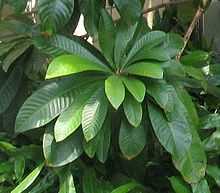Sapotaceae
| Sapotaceae | |
|---|---|
 | |
| Pouteria sapota | |
| Scientific classification | |
| Kingdom: | Plantae |
| (unranked): | Angiosperms |
| (unranked): | Eudicots |
| (unranked): | Asterids |
| Order: | Ericales |
| Family: | Sapotaceae Juss.[1] |
| Type genus | |
| Manilkara Adans.[2] | |
| Subfamilies | |
_W_IMG_0242.jpg)
The Sapotaceae are a family of flowering plants belonging to order Ericales. The family includes about 800 species of evergreen trees and shrubs in around 65 genera (35-75, depending on generic definition). Their distribution is pantropical.
Many species produce edible fruits, and/or have other economic uses. Species noted for their edible fruits include Manilkara (Sapodilla, sapota), Chrysophyllum cainito (star-apple or golden leaf tree), Pouteria (abiu, canistel, lúcuma, Mamey sapote), Vitellaria paradoxa (shea) and Sideroxylon australe (Australian native plum). Shea (shi in several languages of West Africa and karité in French; also anglicized as shea butter) is also the source of an oil-rich nut, the source of edible "shea butter", which is the major lipid source for many African ethnic groups and is also used in traditional and Western cosmetics and medications. The 'miracle fruit' Synsepalum dulcificum is also in the Sapotaceae.
Trees of the genus Palaquium (gutta-percha) produce an important latex with a wide variety of uses.
The seeds of the tree Argania spinosa (L.) Skeels produce an edible oil, traditionally harvested in Morocco.
The family name is derived from zapote, a Mexican vernacular name for one of the plants (in turn derived from the Nahuatl tzapotl) and Latinised by Linnaeus as sapota, a name now treated as a synonym of Manilkara (also formerly known by the invalid name Achras).
Genera
|
|
| Wikimedia Commons has media related to Sapotaceae. |
References
- ↑ Angiosperm Phylogeny Group (2009). "An update of the Angiosperm Phylogeny Group classification for the orders and families of flowering plants: APG III" (PDF). Botanical Journal of the Linnean Society 161 (2): 105–121. doi:10.1111/j.1095-8339.2009.00996.x. Retrieved 2013-07-06.
- ↑ "Sapotaceae Juss., nom. cons.". Germplasm Resources Information Network. United States Department of Agriculture. 2003-01-17. Retrieved 2009-04-06.